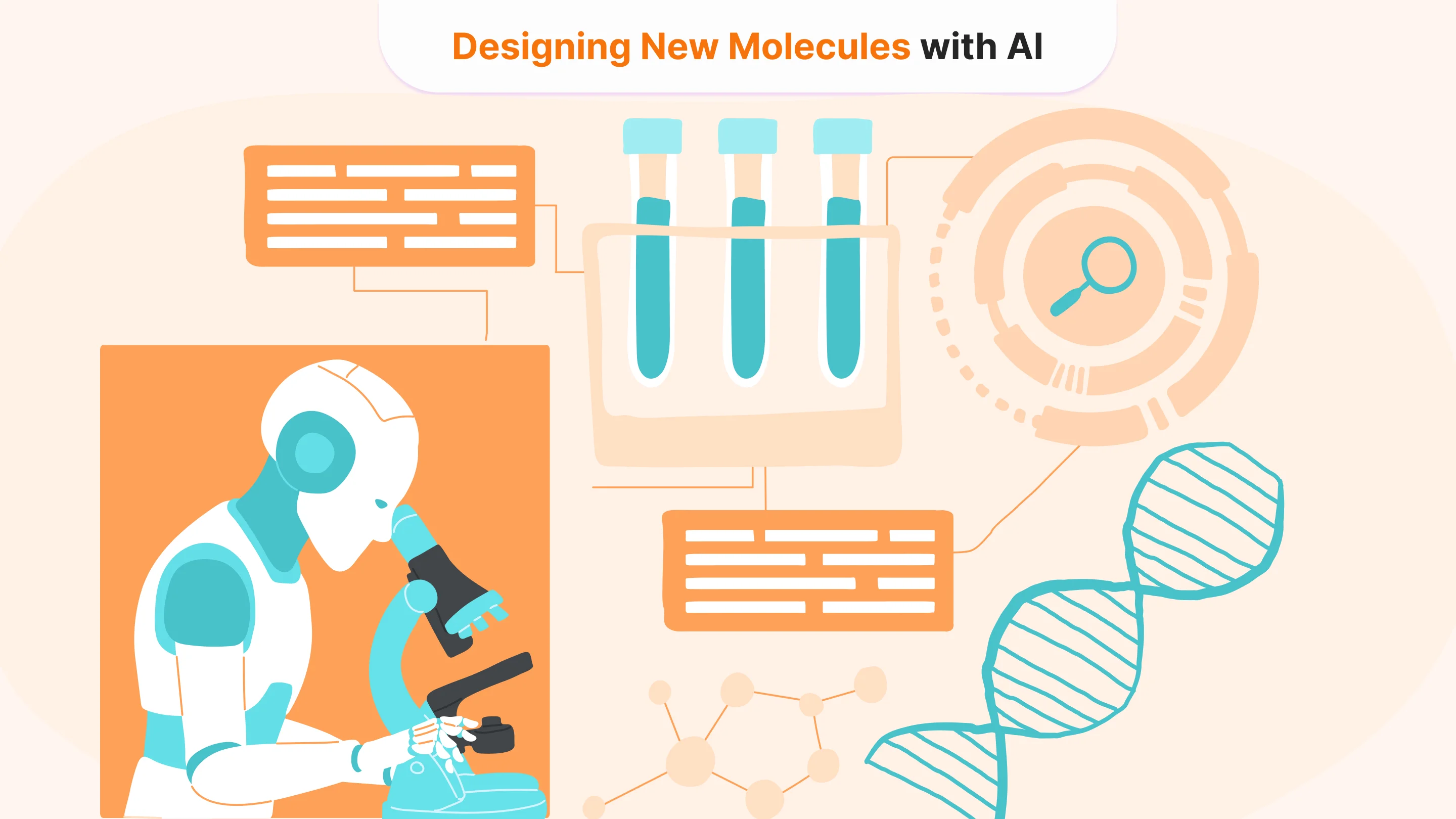

Repurposing and Developing Drugs With the Aid of AI
For decades, the process of developing a new drug has been described as slow, risky, and expensive. On average, it takes more than 10 years and $2.8 billion to bring a new drug to market. Despite massive investments, over 90% of experimental drugs fail during clinical trials, often due to safety concerns, lack of efficacy, or unforeseen side effects. In short, pharmaceutical research and development (R&D) has reached a breaking point.
At the same time, we are witnessing an explosion of biomedical data — genomic sequences, patient health records, and molecular libraries, growing faster than any human team can analyze. In this data-rich environment, Artificial Intelligence emerges as a transformative force. By using machine learning algorithms, natural language processing, and generative models, AI offers the potential to not only speed up drug discovery but to fundamentally change how it’s done.
In this article, we’ll explore how AI is helping researchers repurpose existing drugs for new diseases and develop entirely new compounds from scratch. Through real-world examples and cutting-edge use cases, we’ll look at the promise — and the challenges — of a future where drugs are designed not just in labs, but also in algorithms.
Repurposing Old Drugs for New Diseases
The idea of drug repurposing isn’t new. Doctors have long discovered secondary uses for approved drugs, often by accident. But AI adds scale and speed to this process. By scanning vast datasets, including gene expression maps, protein interactions, clinical trial records, and published literature, machine learning models can make connections that human researchers would miss. This was evident during the early stages of the COVID-19 pandemic.
UK-based BenevolentAI used its AI platform to analyze how the SARS-CoV-2 virus entered human cells, and within days, identified baricitinib, a rheumatoid arthritis drug, as a possible inhibitor of viral entry. The prediction led to fast-tracked clinical trials, and baricitinib was eventually granted emergency use authorization by the FDA.
Another standout case is Healx, a startup that uses AI to tackle rare diseases. With over 95% of rare diseases lacking approved treatments, repurposing offers a way to skip early safety trials and get faster to the clinic. Healx’s AI platform combines natural language processing and biological network analysis to identify existing drugs that might work for conditions like Fragile X syndrome. It moved from prediction to preclinical validation in just 18 months — a timeline virtually impossible without automation.
These cases demonstrate the value of AI as a discovery engine. It reads faster, integrates more information, and never sleeps. But there are still challenges. Many biomedical databases are incomplete or biased toward well-studied diseases, and the quality of AI output depends heavily on the quality of input data. There’s also the risk of spurious correlations — a drug may appear promising on paper but fail to show any real benefit in practice. Still, AI-driven repurposing is proving itself as a low-risk, high-impact strategy in both emergency and neglected therapeutic areas.
Designing New Molecules with AI

While repurposing is about uncovering new uses for old molecules, de novo drug design is about creating compounds that don’t yet exist. Traditionally, this process involved years of high-throughput screening, trial-and-error synthesis, and repeated cycles of optimization. AI changes that. Today’s generative models — particularly those based on deep learning, such as GANs and variational autoencoders — can generate virtual molecules tailored to specific biological targets. These algorithms are trained on chemical libraries and learn to create new structures with desired properties: binding affinity, solubility, metabolic stability, and more.
One of the best-known examples is Insilico Medicine, which designed an entirely novel drug candidate for idiopathic pulmonary fibrosis using a fully AI-driven pipeline. From initial target selection to preclinical candidate nomination took just 18 months. That compound entered human trials in record time, showing what’s possible when design and discovery are compressed into a seamless computational loop.
Another key player is Exscientia, which developed the first AI-designed drug to reach a Phase I trial — a compound targeting obsessive-compulsive disorder. The whole process took around 12 months, thanks to predictive algorithms that could evaluate thousands of molecules in silico and prioritize only the most promising ones for synthesis.
Atomwise, meanwhile, uses deep neural networks for molecular docking predictions. Instead of testing thousands of compounds in the lab, it screens billions of molecules virtually and ranks their potential efficacy against disease-related proteins. It has been credited with identifying Ebola treatment candidates in under a week, and its platform is now used in partnerships with pharma companies and academic labs worldwide.
These companies show that AI isn't just accelerating discovery — it’s rewriting the rules of what’s possible. Instead of combing through nature’s pharmacy, we’re teaching machines to build new ones from scratch.
Integrating Biological Data for Precision Discovery
One of the major promises of AI lies in its ability to integrate multiple layers of biological and clinical data. This includes genomics, transcriptomics, proteomics, and real-world patient outcomes. Together, these data types form a high-dimensional picture of disease, and AI is uniquely suited to interpret it. Take Deep Genomics, a company focused on RNA-based therapeutics. Its AI platform is trained to analyze genetic mutations and predict which types of RNA-splicing errors might cause disease. The system then identifies potential drug candidates that could correct those errors. In 2019, Deep Genomics used this approach to nominate a candidate for Wilson disease, a rare inherited disorder, and advanced it rapidly to preclinical development.
Beyond genomics, AI can also mine electronic health records and insurance claims to find new drug opportunities. For example, the company nference uses natural language processing to extract insights from unstructured clinical notes, helping pharma companies track how drugs perform in the real world, not just in trials.
These “real-world data” insights can reveal off-label uses, unexpected side effects, or subpopulations that benefit more than expected. Another emerging concept is the digital twin — a computational model of a patient that can be used to simulate different treatment responses. With AI, it becomes possible to build such models and test how hypothetical patients might respond to various compounds before ever enrolling in a trial. In theory, this could drastically improve patient matching and trial success rates. Together, these advances point toward a future of precision drug discovery, where treatments are not just effective but tailored to individual biology and context.
Main Challenges
As with any powerful technology, AI in drug discovery comes with serious caveats. First and foremost is data quality. AI models depend on clean, representative, and comprehensive datasets. But in healthcare, data is often fragmented, biased, or locked behind privacy regulations.
For example, underrepresented populations may be excluded from clinical datasets, leading to models that perform poorly in diverse patient groups. Then there’s the issue of explainability. Many AI models operate as black boxes — they can produce a result, but it’s often unclear how they got there. In a highly regulated industry like pharmaceuticals, this creates problems. Regulatory agencies, physicians, and even investors need to understand the rationale behind a decision to pursue a particular molecule. Without transparency, trust becomes a barrier to adoption.
Regulatory frameworks themselves are also in flux. While agencies like the FDA have begun to issue guidance on AI in clinical trials and medical devices, there are few clear rules around AI-generated compounds. Who owns the intellectual property if an algorithm designs a drug? Who is liable if it fails? These are unresolved questions with implications for both innovation and accountability.
Finally, ethical concerns loom large. As AI enables faster discovery, there’s a risk that access to new treatments could become even more unequal. If drug design is outsourced to proprietary algorithms owned by private companies, will their benefits reach underserved populations? Or will AI simply reinforce the same market-driven structures that already limit access to care?
Conclusion
Despite these challenges, AI is here to stay. Its momentum is not theoretical; it’s reflected in billion-dollar deals between pharma giants and AI startups, in drugs already in clinical trials, and in pipelines that are now shaped as much by data scientists as by chemists. We are entering an era of multimodal AI, where models can interpret text, images, omics data, and patient records in tandem. Companies are using high-throughput imaging combined with AI to identify phenotypic changes in cells, effectively teaching machines to “see” biology. Techniques like federated learning are being explored to allow collaboration across institutions without sharing raw patient data, enabling privacy-conscious research on a global scale.
Artificial intelligence is transforming the way we find, test, and bring drugs to patients. From repurposing existing molecules to generating entirely new compounds, AI is no longer a peripheral tool — it’s becoming a central player in pharmaceutical R&D. By combining speed with precision and pattern recognition with creativity. Industry analysts project that by 2035, AI-driven platforms could reduce average development time to 3–5 years, with costs dropping below $500 million for a growing number of compounds. Some early-stage programs may be completed in as little as 18 months. Over a 20-year horizon, we may see the emergence of fully AI-integrated discovery pipelines, where hypothesis generation, molecular design, and even clinical trial simulation occur largely in silico before the first human dose is administered.
Tell us about your project
Fill out the form or contact us

Tell us about your project
Thank you
Your submission is received and we will contact you soon
Follow us
